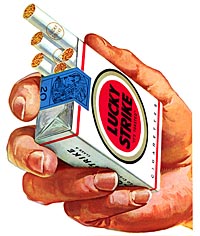2 - Stories from Galicia 1959 :
by Michael Furstner
--------------------------
Previous - Next - Contents
 A Celtas for Professor den Tex
A Celtas for Professor den Tex
As a Geology student in Spain I thoroughly enjoyed the shear romance
surrounding cigarets.
The cheapest Spanish brand on the market was
Celtas, cigarets of very roughly cut tobacco (frequently including
tobacco leaf veins) rolled in yellowish paper (like these Gitanes on the
adjacent photo).
I quite liked these, smoked them most of the time, and once
caused considerable consternation and commentary from my fellow students when I
offered one to our Professor den Tex when he visited us on his
annual inspection tour in Galicia. He good naturedly accepted the Celtas and smoked it happily without a single complaint.
Next in hierarchy were Gitanes (in
either white or yellow paper), the Spanish equivalent in style and taste to the
French Gauloises. The up market Spanish national brand was Bisonte
contained in a glossy, American style package, quite acceptable in
taste.
The ultimate in smoking ecstasy in Spain however were
American cigarets (Chesterfield, Lucky Strike and Camel), not imported
through the regular channels but smuggled in as contraband by the numerous
vessels arriving at the various small ports on Spain's North coast. These were
exclusively sold "under the counter" in every self respecting pub in the
country (and much cheaper than in Holland).
For me there was no greater joy than to casually lean on the bar
counter, wink at the bar man with a knowing look and then whisper behind my
hand "Chester por favor". Upon which the barman, after a cautious quick
look left and right, would reach under the counter and, covered under the palm
of his hand, offer me a packet of Chesterfield.
 But wait, there is more !! If buying a packet of "Chester" or
"Lucky" was Heaven, lighting a cigaret in Spain was almost as
good.
But wait, there is more !! If buying a packet of "Chester" or
"Lucky" was Heaven, lighting a cigaret in Spain was almost as
good.
The two most prized possessions (in those days) of any country Spaniard
and us Geology students alike, were his botta and his labourer's
lighter (Spanish name ?? I forgot).
Bottas then were the genuine pigskin article (not those horrible plastic tourist
ones you buy today), the skin turned inside out, with the bristles tarred. You
needed to cure the inside with red wine for a week or so before the tar taste had
disappeared and the wine was drinkable, but after that the botta would last you
for a lifetime of pleasure (provided you kept it filled and not let dry out).
The labourer's lighter was a magical instrument. It consisted of a thin
hollow brass (?) rod, just over half a centimeter in diameter and 5 cm (2
inches) high. On top of it, on the side was a 1cm diameter toothed wheel, which,
when struck with a flat hand, produced a spark from the metal flint underneath
that ignited the top of the wick protruding from the hollow rod. You blew on the
wick to increase its ember with which you then lighted your cigaret. The wick
was typically 50-60 cm (2 feet) long and encased in a tight yellow mashed
"stocking". You rolled the wick in a special way in a coil so that it did not extend
longer than about 8 cm (3 inches) from underneath the lighter's metal rod. As you used the lighter the wick (and coil) would reduce in length over time.
My road labourer friend Peppe (who was in charge of a 7 km stretch of
dirt road halfway between Carballo and Santiago de Compostela) always proudly
called his lighter contra viento y marea ("against wind and weather"),
which indeed it was.
Back in Holland us Geology students would always carry our contra viento
in our pockets at official balls, and, dressed in immaculate black
tails, light our ladies' cigarets with it with great showmanship and pride. Our contra vientos
were always considered well above the otherwise strict etiquette rules.
For over 20 years I carried with me from those days the cover of an empty packet
of Lucky Strikes on which (in 1960) a lovely and very attractive Spanish
young lady which I met at a Fiesta in Caión, had written her name : Maria Luz Pet Morales. After that wonderful
Fiesta (now 50 years ago) I never met her again.
Next Page -
Top of Page
Copyright © 2010 Michael Furstner
|